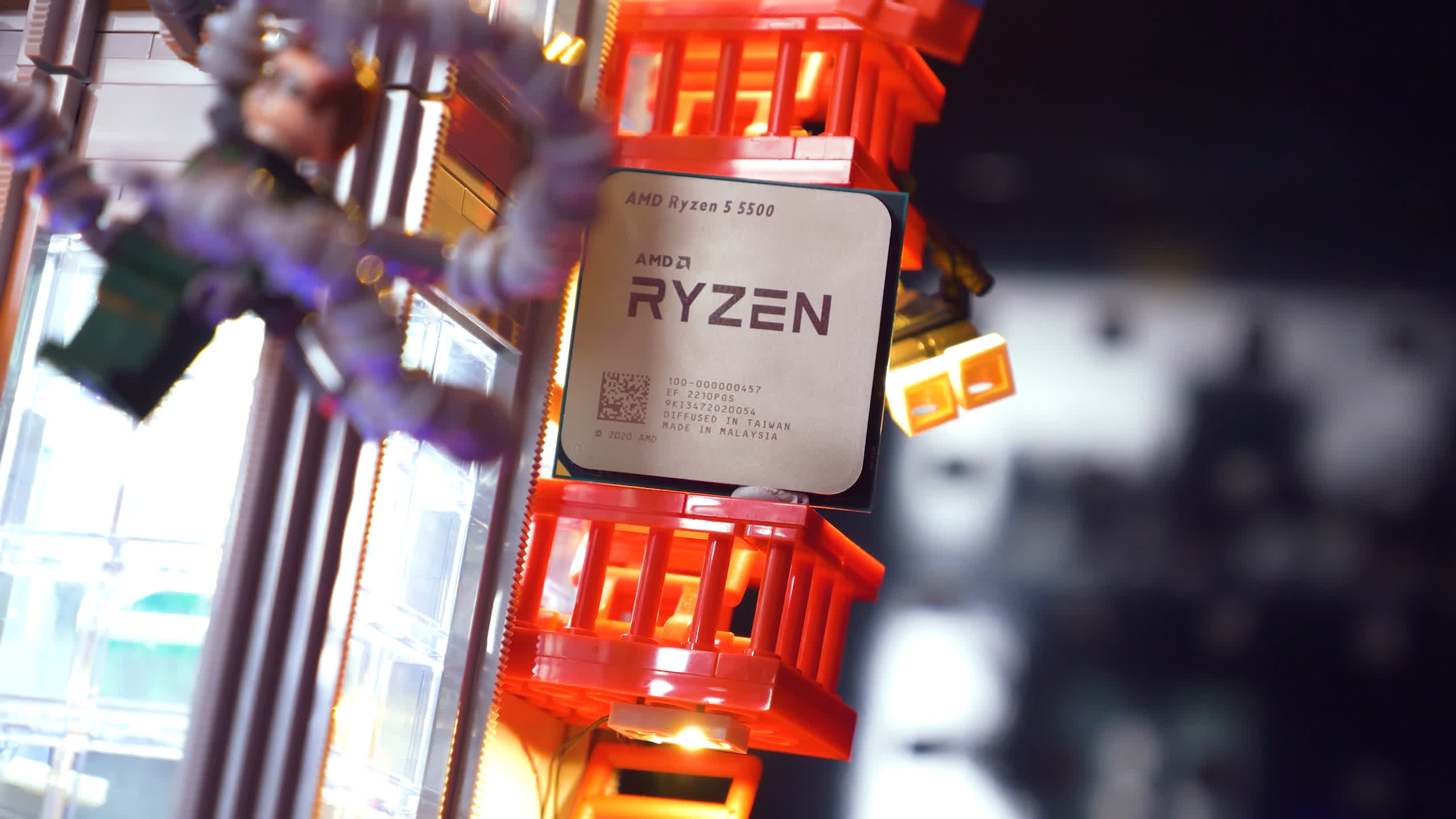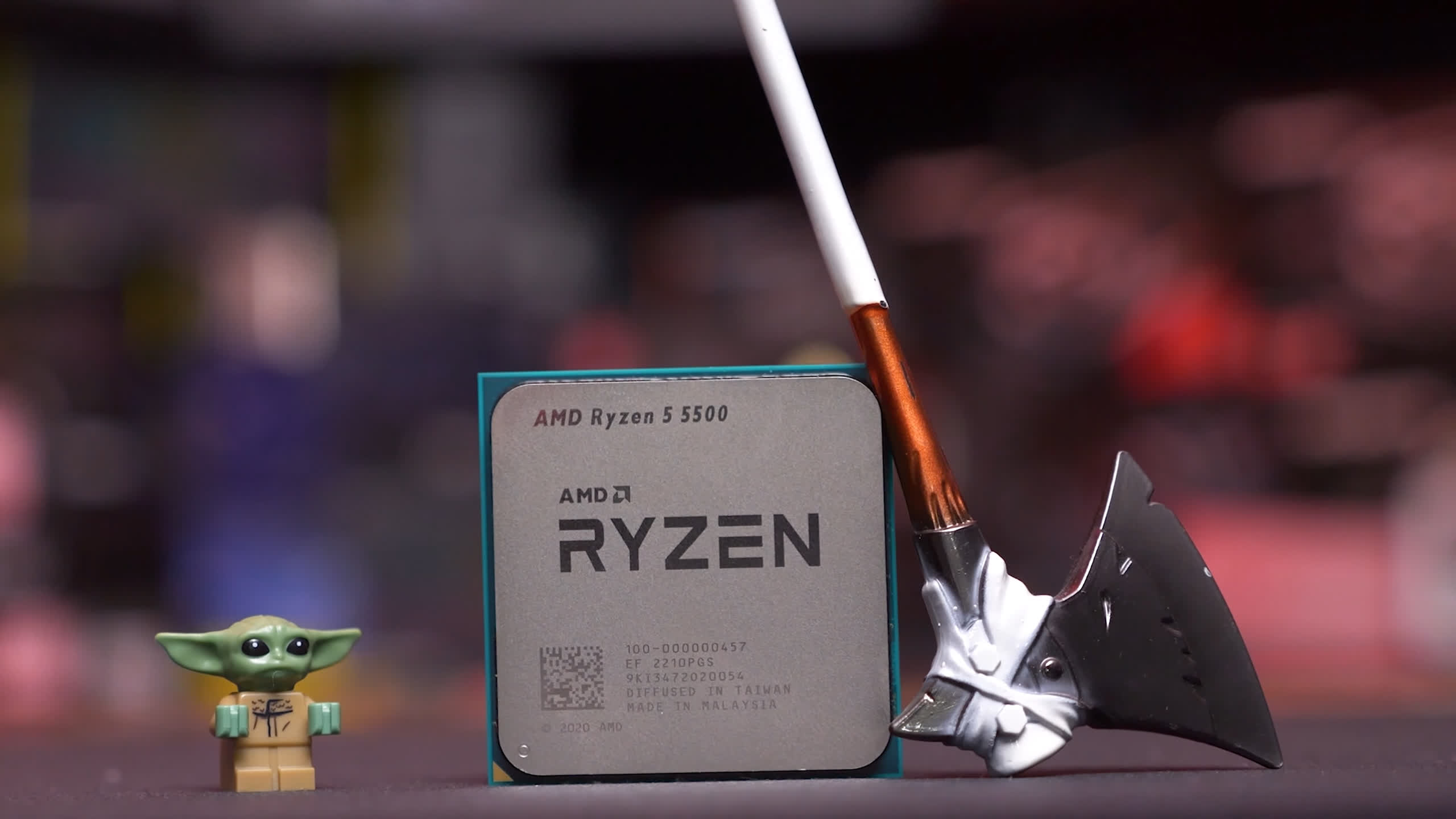AMD Ryzen 5 5500
Today we’re finally taking our first look at the Ryzen 5 5500. Surprisingly enough, this CPU was released about three months ago and it’s the cheapest Ryzen 5000 series part you can have, so you’d think we’d be all over it, but for a few reasons we’ve missed that coverage.
The short version is that the R5 5500 was quietly released back in April and AMD didn’t sample media in time for a day-one review, instead we got our sample a week after they hit shelves. At that point it was kind of old news, so we moved on to other things.
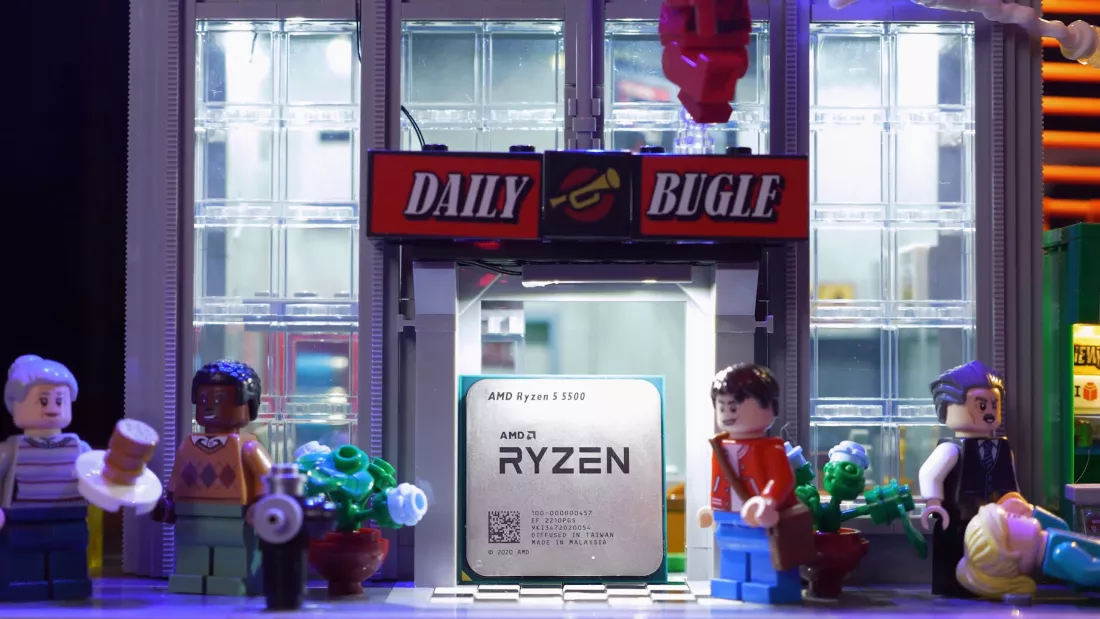
Recently though, after comparing the Ryzen 5 3600 and 5600 we were asked by many for a comparison with the 5500, given it can be snapped up for $140. That’s a $40 discount from the Ryzen 5 5600, which isn’t much, but then going purely by the name it doesn’t sound like there’s much difference between these two chips either… and that’s what makes the 5500 a sneaky move by AMD.
The Ryzen 5 5500 and 5600 are vastly different products. Surely, they are both Zen 3 based, 6-core/12-thread processors, but they’re based on different designs. Whereas the 5600 is a Vermeer model, the 5500 uses the APU design codenamed Cezanne. In short, the 5500 is a 5600G with the iGPU removed and that means when compared to the 5600 you’re getting half the L3 cache at 16MB and only PCIe 3.0 support.
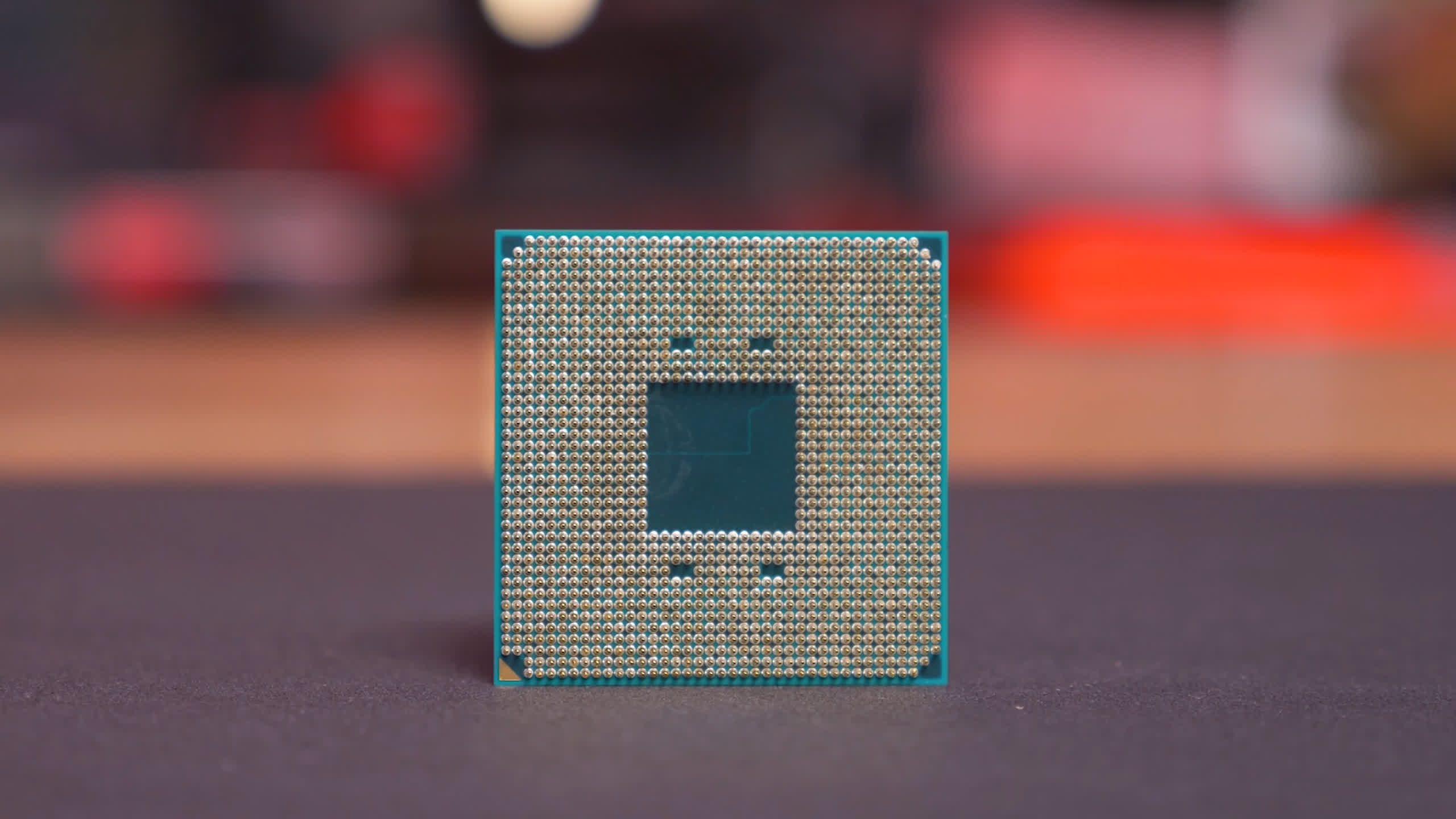
The L3 cache downgrade alone is a big one as we’ve seen it lead to underwhelmight gaming performance for the 5600G and 5700G when compared to full fledged Zen 3 parts. It sounds like many of you using older Ryzen 5 parts want to know if the 5500 is a worthwhile upgrade, or should you just opt for the 5600 or higher, so today we’re going to find out.
For this one we’ve got a 21 game benchmark at 1080p and 1440p using both the Radeon RX 6950 XT and 6600 XT, with SAM enabled. The motherboard used for testing is the old MSI B350 Tomahawk using the latest BIOS revision based on the AGESA 1.2.0.7 microcode, which enables Resizable BAR along with support for Ryzen 5000 processors. Then we have 32GB of DDR4-3200 CL14 dual-rank dual-channel memory, and this same configuration was used for testing all Ryzen processors.
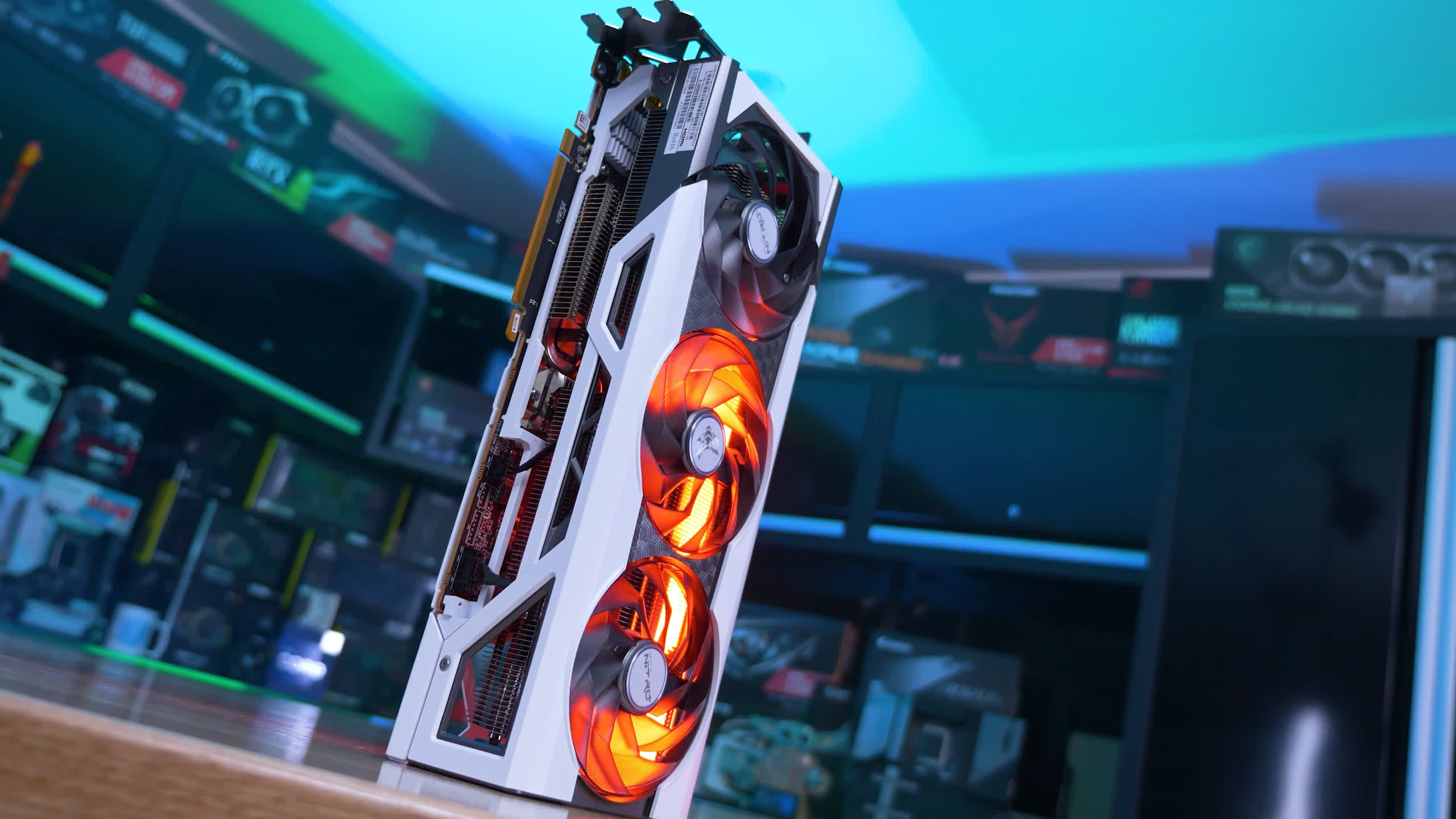
With those details out of the way, let’s go over a few of the games and then we’ll take a look at the 21 game average.
Benchmarks
Starting with ACC, we find that the 5500 is slightly slower than the old 3600, trailing it by a 5-8% margin depending on the configuration and that means the 5600 is up to 35% faster, seen when using the Radeon 6600 XT, which is a bit odd as the CPU bottleneck was stronger than what we saw with the 6950 XT.

What isn’t odd is the fact that the 5500 is slower than the 3600 in this title. We know from testing with the 5800X3D that ACC is extremely sensitive to cache capacity and with the 3600 packing a 32MB L3 cache, even if it is 16MB per CCX, it has a real advantage over the 5500 which has a total of 16MB. So a disappointing start for the entry-level Zen 3 part.
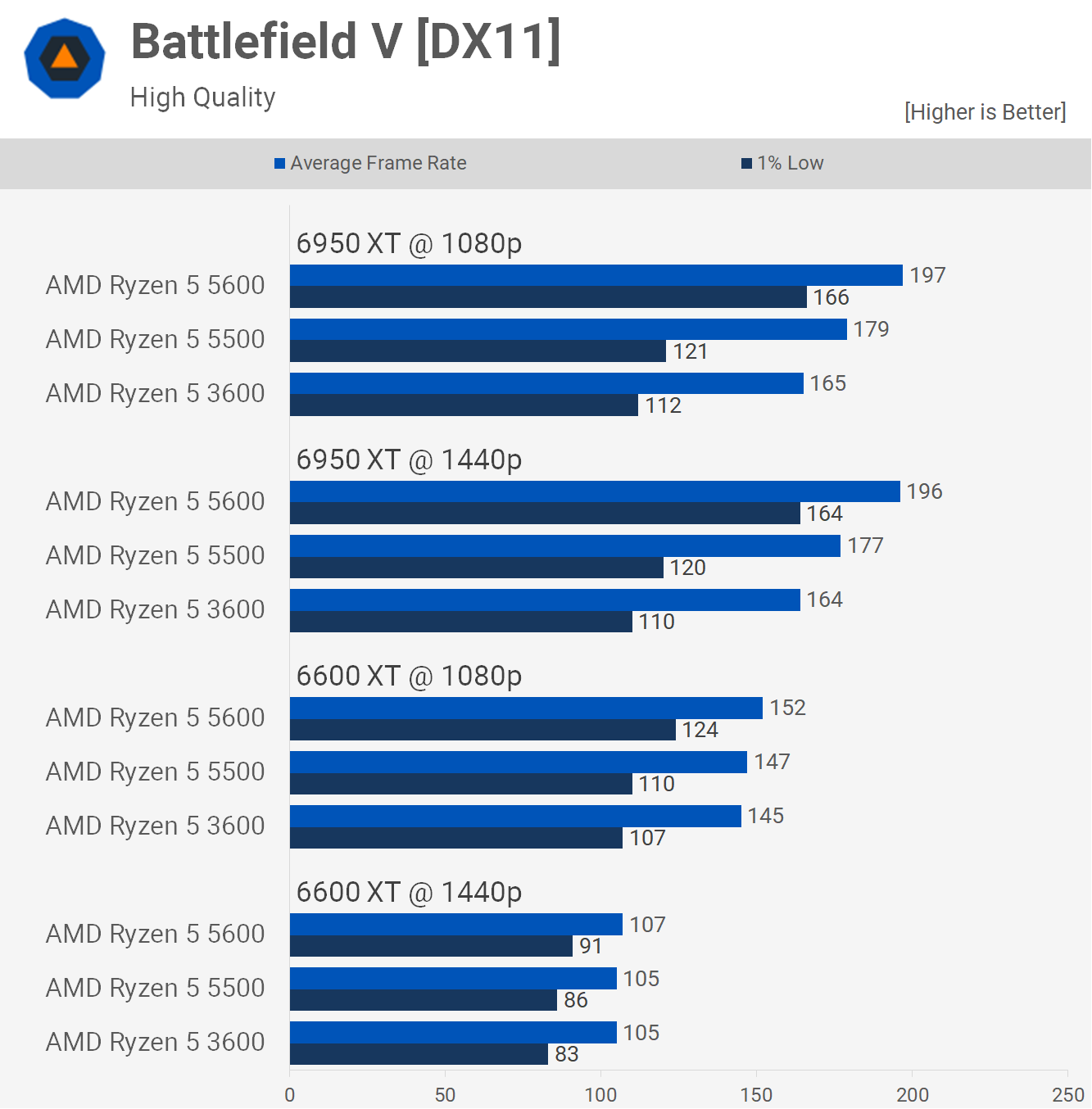
The 5500 looks more competent in Battlefield V, edging out the older 3600 by around an 8% margin with the 6950 XT. When compared to the 5600 the average frame rate wasn’t that much lower, just 9% separated them at 1080p with the 6950 XT. However, it was the 1% lows that presented as the biggest issue for the cutdown Zen 3 part, dropping by almost 30% when compared to the 5600. That said, this issue was far less noticeable with a more mid-range GPU such as the 6600 XT where performance was similar between all three CPUs.

Cyberpunk 2077 is primarily GPU limited, even with the dialed down high quality preset. Even so the 5500 was able to just edge out the 3600, but overall all three CPUs lead to a similar gaming experience due to graphics card performance being the primary frame rate limitation here.
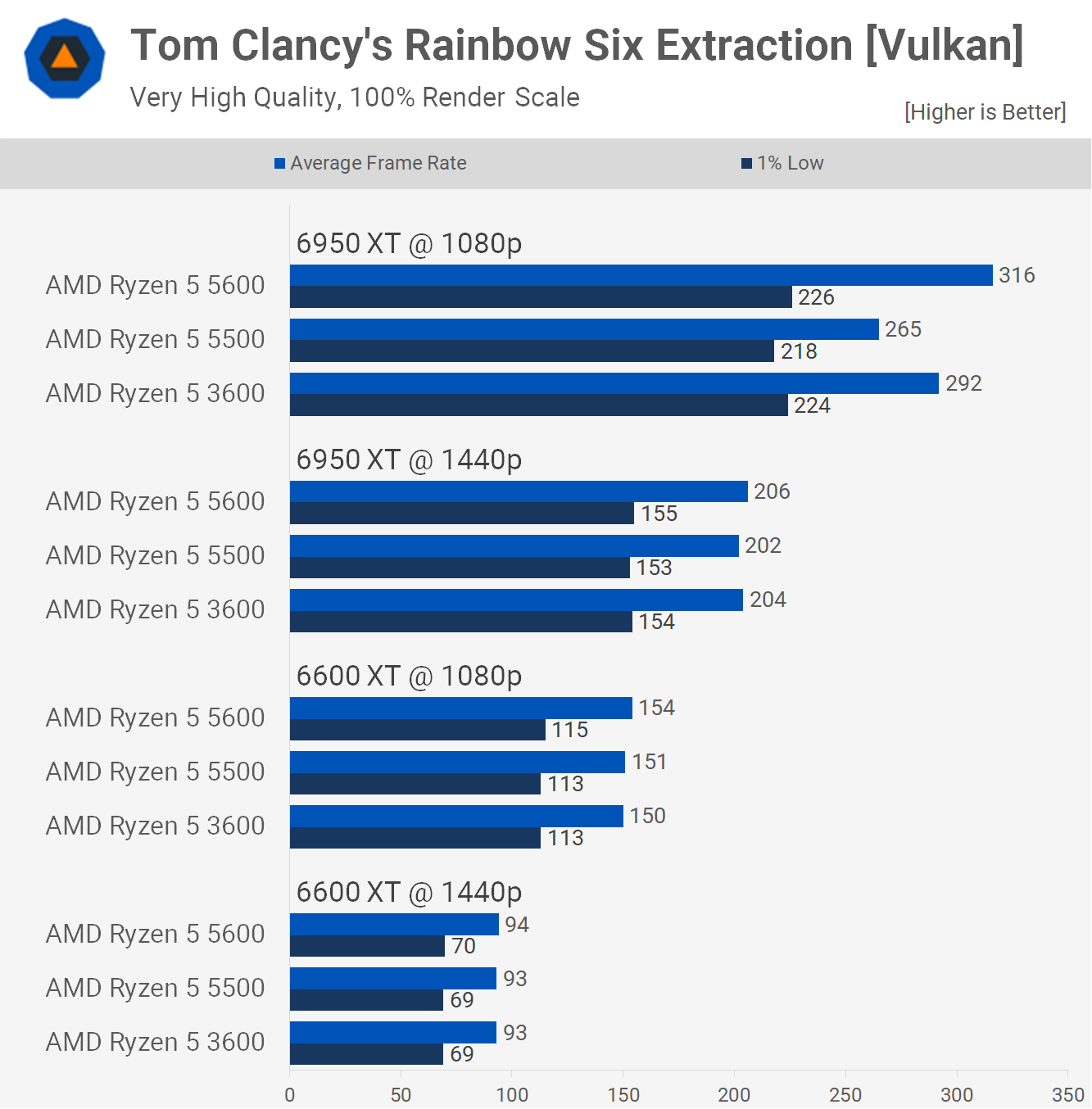
Next up we have Rainbow Six Extraction and we see that for the most part any one of these CPUs will deliver a first class experience as we’re not running into a CPU bound scenario until frame rates get up over 250 fps. Still it’s the 5500 that’s the first CPU to hit the wall, seen when using the Radeon 6950 XT at 1080p, so that’ll be disappointing news for 3600 owners hoping for a cheap upgrade.

Performance in F1 2021 is similar between the 3600 and 5500. This time the budget Zen 3 model was a little faster, but we’re only talking about up to an 8% improvement for the average frame rate and almost no change to the 1% lows. Meanwhile, in our most CPU limited testing, the 5600 is almost 40% faster which is a crazy difference given how similar the 5500 and 5600 sound.
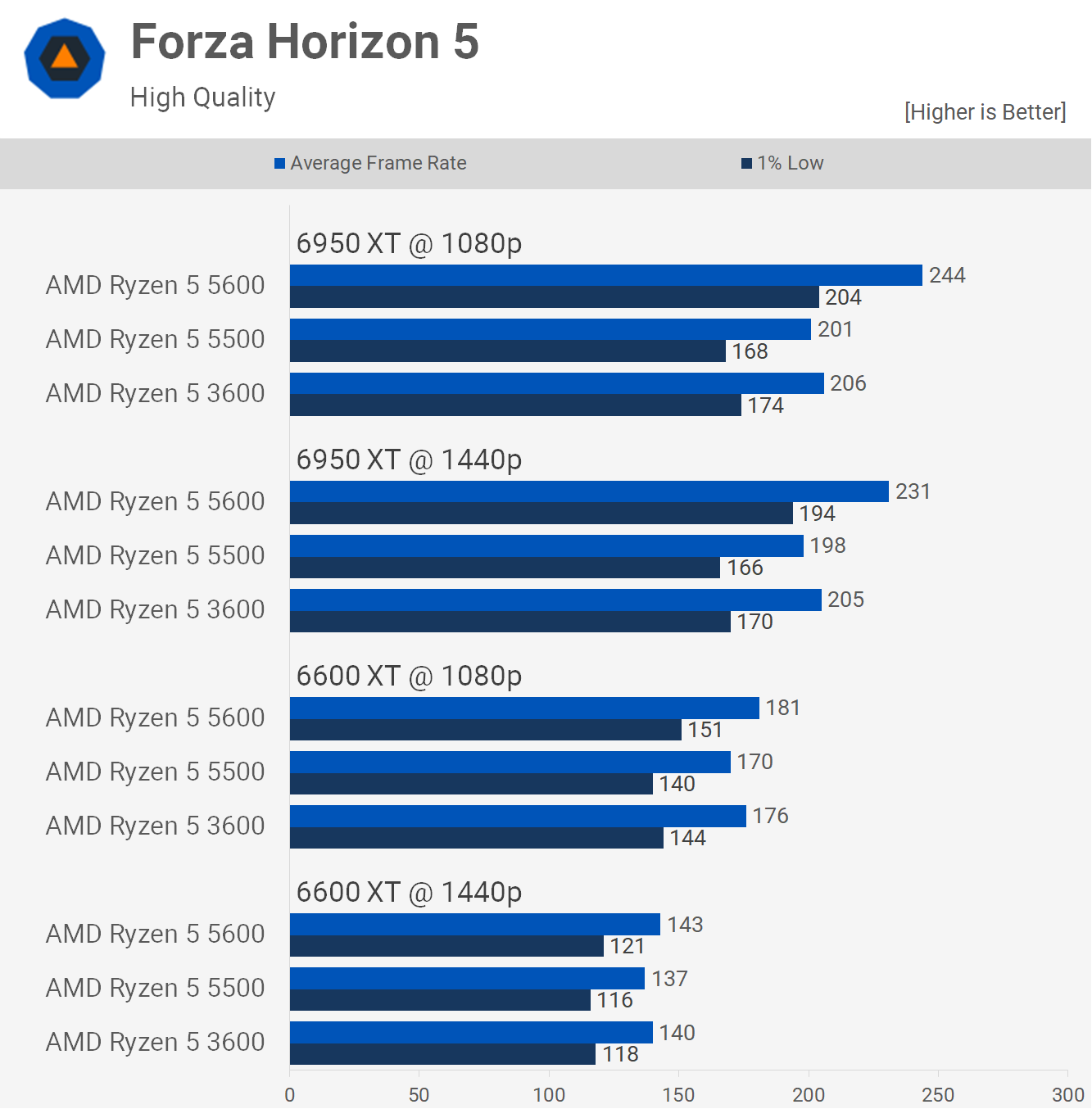
Moving on to Forza Horizon 5, we find once again that the 5500 is delivering 3600-like performance. This means that the 5500 is ~20% slower than the 5600 in our most CPU bound testing for this title.

Hitman 3 is another example of the 5500 delivering 3600-like performance, though again in our most CPU limited testing it was a few percent slower. There’s not a big difference between these three CPUs for Hitman though and for this sort of title over 100 fps at all times is perfectly acceptable.
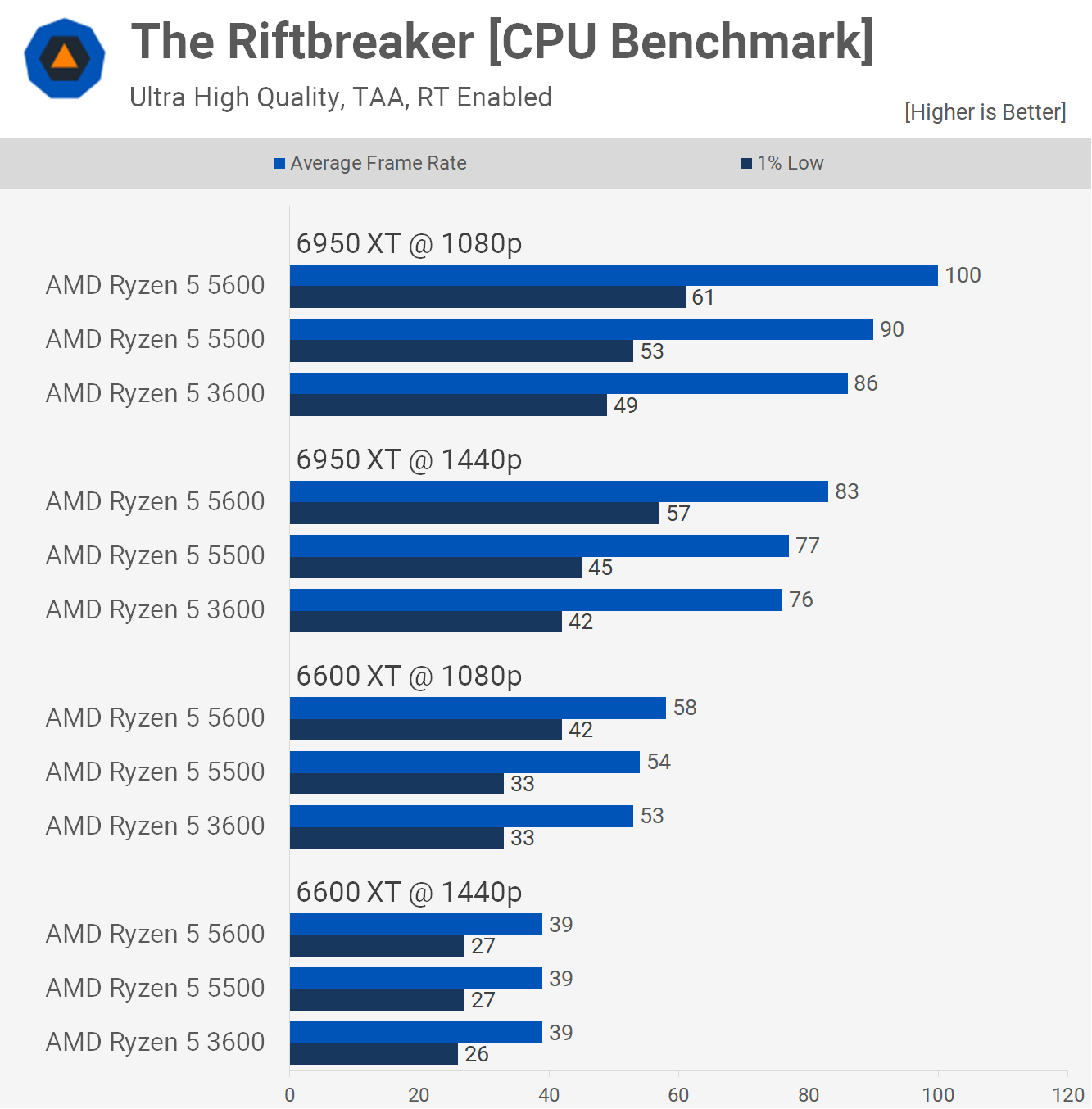
The Riftbreaker CPU benchmark is much more demanding than Hitman, so here those 1% lows will matter and thankfully the 5500 is faster than the 3600, if only by an 8% margin. The 5600 was up to 15% faster, and did manage to keep the 1% lows above 60 fps with the 6950 XT at 1080p.
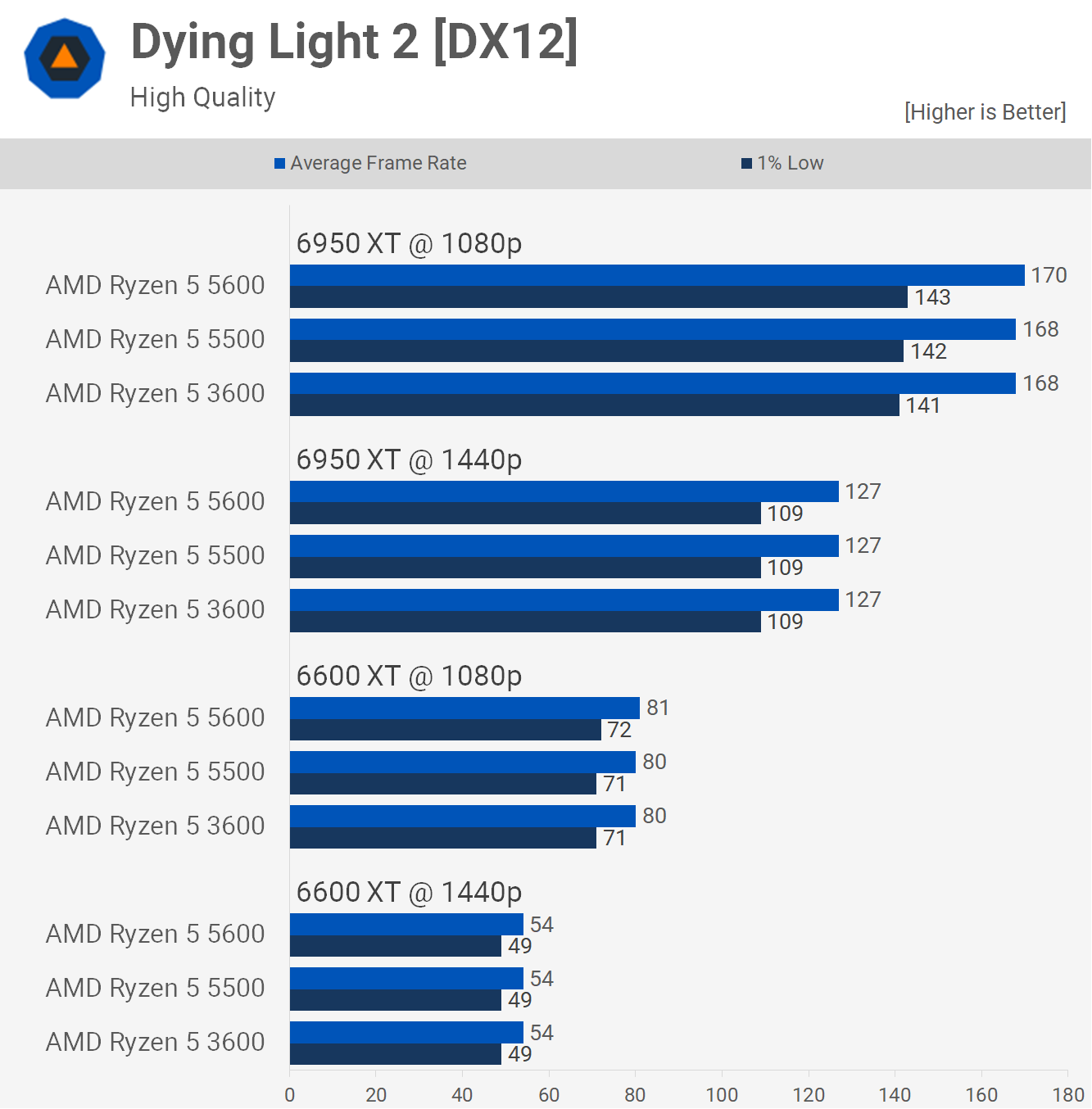
Dying Light 2 is a good example of a typical modern single player game in the sense that it’s heavily GPU bound using current generation processors. Basically it doesn’t matter which of these CPUs you use for this sort of game, you’ll always be limited by your graphics cards.
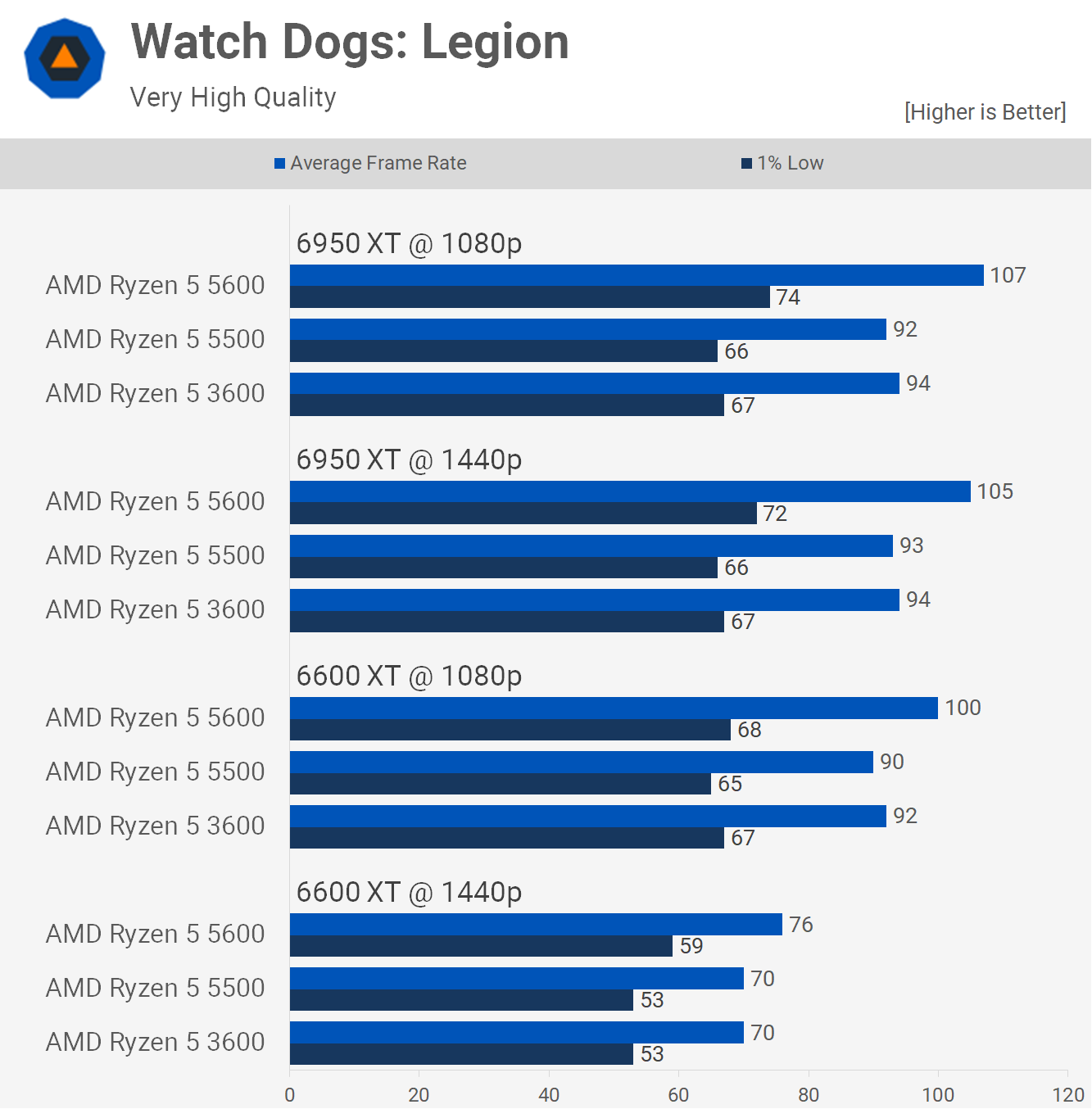
The last game that we’re going to look at individually, Watch Dogs Legion shows yet again the 5500 deliver 3600-like performance. The 5600 is about 16% faster at best, which is not a massive difference, but it’s unlikely Zen 2 owners will be interested in the 5500.
21 Game Average
Looking at our 21 game average, we see that overall the Ryzen 5 5500 is delivering 3600-like performance, in fact quite remarkably the two were identical, for all test configurations. For our most CPU bound test configuration with the Radeon 6950 XT at 1080p, the 5600 was 17% faster, which is not a massive margin, but still big enough as we would see a smaller margin comparing the 5600 with the 5900X or 5950X on gaming tasks.
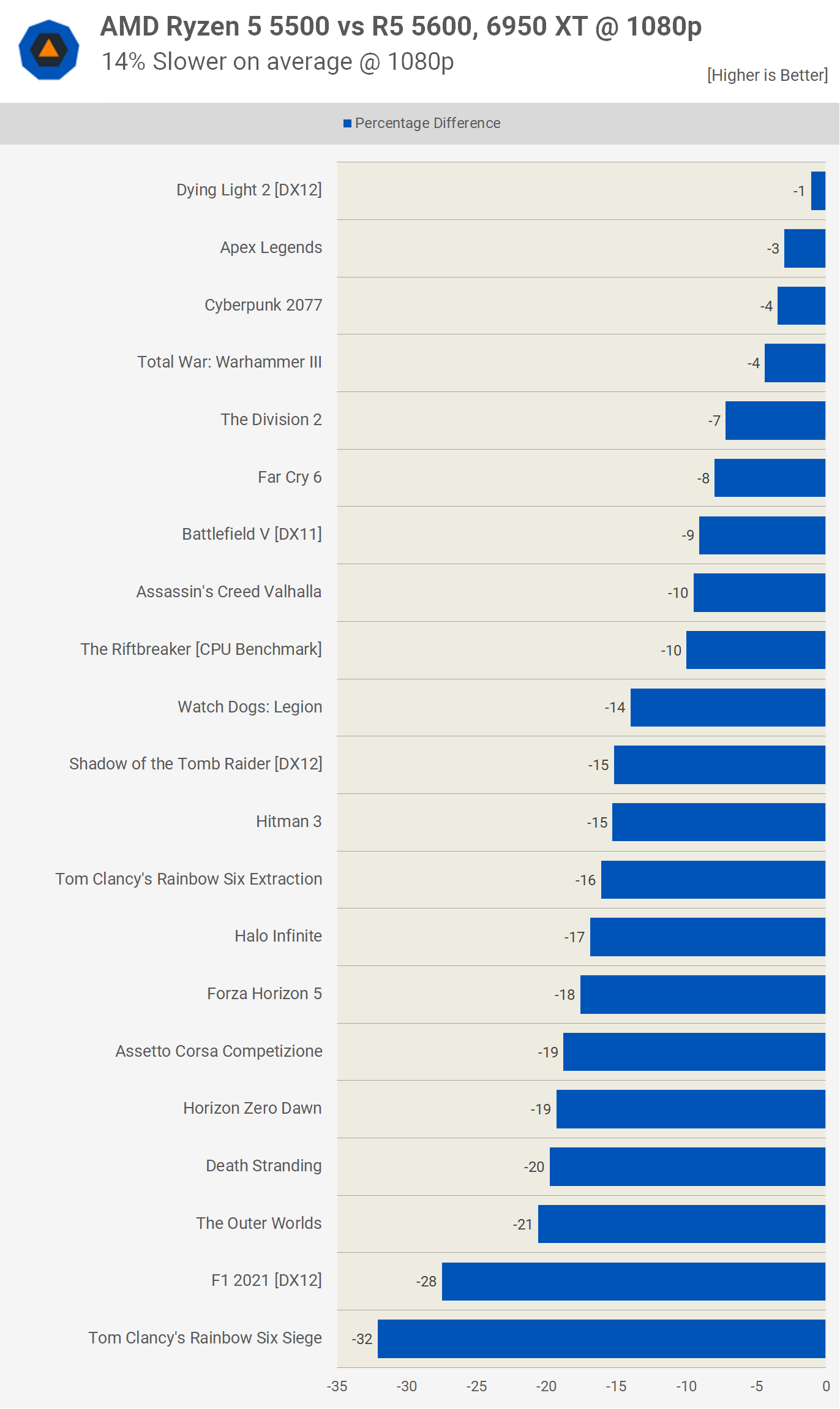
Since the 5500 and 3600 are basically identical, here’s a per game comparison with the 5600. The 5500 was 14% slower on average at 1080p using the 6950 XT data, and we see four examples where the margin exceeded 20% and even one where it grew as large as 32%.
Still there’s those heavily GPU limited titles such as Dying Light 2 and Cyberpunk 2077 where we saw little to no difference between the 5500 and 5600, and this will happen in a lot of games, particularly single player titles where gamers typically prioritize visuals over frame rates.
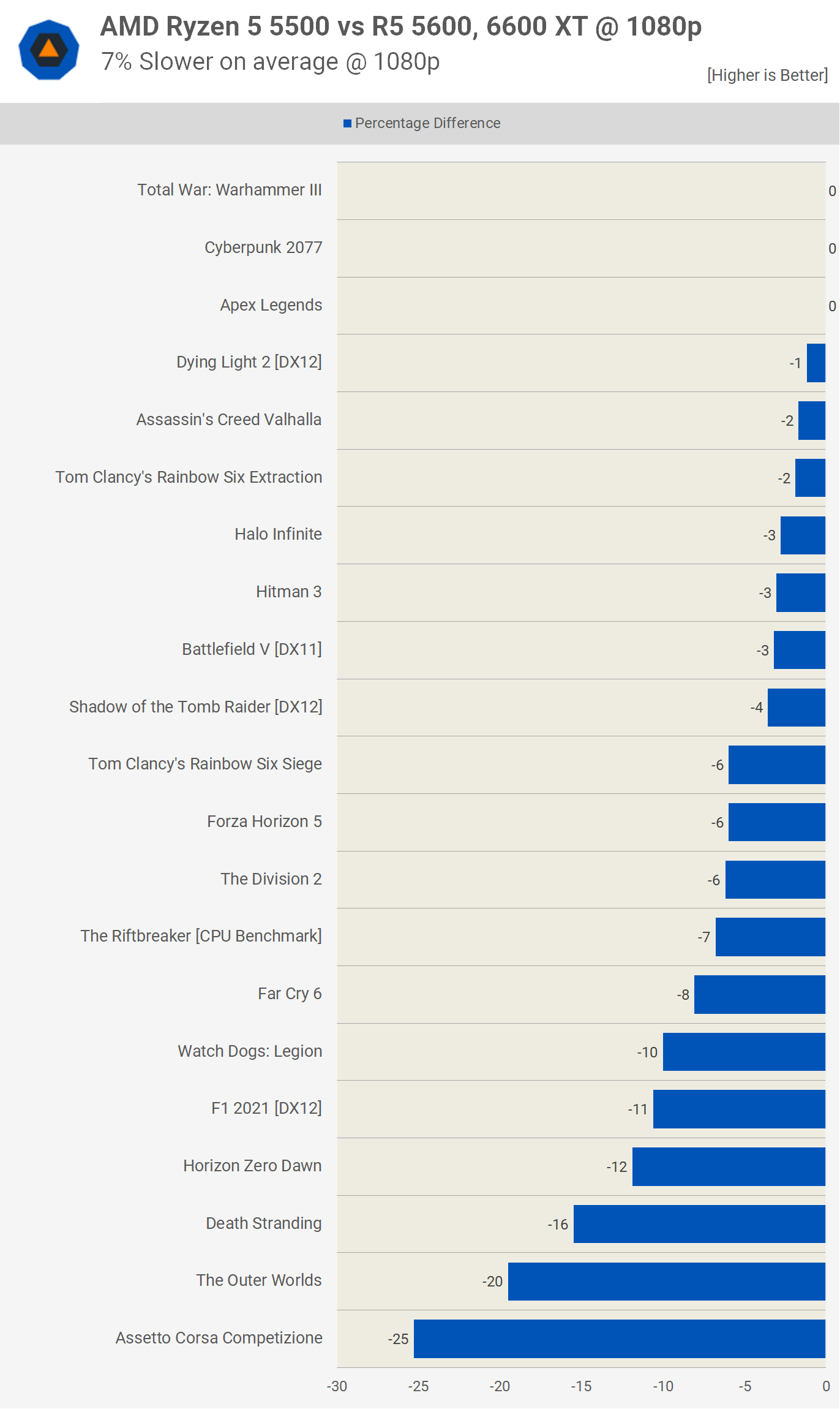
With the slower Radeon 6600 XT the margin was reduced and now the Ryzen 5 5500 was just 7% slower on average. The vast majority of the games tested saw single-digit margins, so for those using a current generation mid-range GPU that won’t be running every game using competitive quality settings, the R5 5500 will be just fine, but ultimately you are better off spending that little bit extra on the 5600.
Budget Zen 3, What We Learned
The Ryzen 5 5500 certainly works well, but realistically if you’re on a budget yet remain a performance-minded enthusiast, this CPU should be avoided even at $140. At that price, the R5 5500 is about 20% more affordable than the 5600, and we only found it to be 14% slower under extreme conditions, but we’re also talking about $40, and of course, there are other considerations such as the lack of PCIe 4.0 support.
Assuming you’re building a new system or carrying out a platform upgrade, adding a $100 motherboard to the equation reduces the cost saving of the 5500 to 14%, add in memory and whatever else you need and it’s going to be a very small saving.
Then for those already on the AM4 platform, the 5500 might seem like an attractive option, given it’s a very affordable Zen 3 processor. But again, it should be thought of more as a Ryzen 5 3600 and you can regularly snap those up for under $100 on eBay. We know, new vs. used, is a bit of an apples to oranges comparison, but the point is if you’re after a cheap AM4 upgrade you can achieve the same level of performance for a lot less on the second hand market.
This begs the question, if you’re already on the AM4 platform, what kind of CPU do you have to own in order for the Ryzen 5 5500 as an upgrade to make sense, because it’s certainly not the 3600, and you wouldn’t upgrade from the 2600 to the 3600, so it’s not 2600 owners either. You’d probably have to be using a quad-core Ryzen processor — think the Ryzen 3 1200, 1300X, Ryzen 5 1400, 1500X or maybe the Ryzen 3 3100 or 3300X — though very few people bought those parts due to limited stock.
That’s where we see the Ryzen 5 5500 kind of making any sense, but even then we’d recommend you to try and extend your budget for the 5600.
If you’re building a new PC from scratch, the Ryzen 5 5500 is a hard pass, don’t even consider it. For $35 less, the Core i3-12100F will easily beat the 5500 as it was 14% faster than the Ryzen 5 3600 in our day-one review, even when limited to the 58W TDP. So assuming you’re looking at building the most affordable gaming PC possible, the Ryzen 5 5500 at $140 makes no sense when you can snap up the 12100F for $105 and throw it on a quality B660 board like the MSI B660M Bazooka for $140, or a middling entry-level B660 board for $100, where it will work just fine, but that will limit your upgrade path.
The Core i3-12100F will at the very least support PCIe 4.0 devices on budget boards and has the ability to utilize PCIe 5.0 as well as DDR5 memory, so not only is it faster for gaming and cheaper, it also supports newer technologies.
Bottom line, Core i3-12100F for budget builders or the Ryzen 5 5600 for those already on the AM4 platform looking for an affordable Zen 3 processor. As noted throughout this review, it’s a shame the 5500 is so similar to the 5600 in name because they’re very different parts especially because of the difference (or lack thereof) that big 32MB L3 cache.



